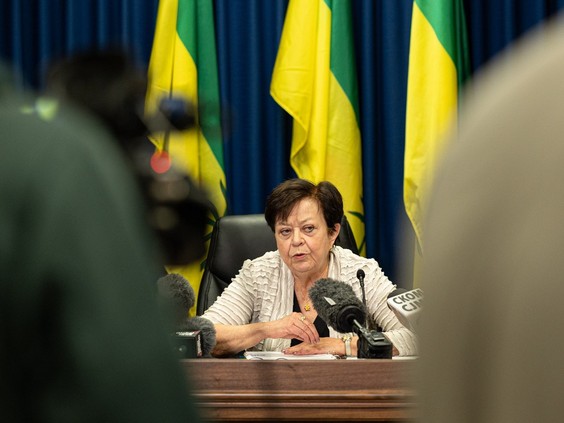
Finance minister Donna Harpauer says the government also spent more this quarter due to wildfires this spring, as well as a non-cash pension expense
Thia James, Saskatoon StarPhoenix
The Saskatchewan government on Tuesday reported its projected surplus is now halved from the $1 billion it projected in March to $485.5 million at first quarter.
The province blamed higher than expected non-cash pension expenses and spending related to wildfires, as well as lower resource revenues, for the surplus forecast falling by $532 million.
Finance Minister Donna Harpauer, speaking to media in Saskatoon on Thursday, said while the province’s finances remain “in a strong position,” this forecast “demonstrates the importance of prudent and careful management of our spending.”
When asked if this is a warning to anyone asking for increased spending in other areas, Harpauer said the government will be very cautious. She said resource revenue is volatile and forecasts can change quickly due to global effects on prices and production.
The province’s finances face pressures from other sources as well.
Harpauer identified the potential effects of drought on crop insurance, and the expense of teachers’ wages once the collective bargaining agreement between the boards of education, the province and teachers is settled, as possible pressures in the next quarters.
She also expects the effects of the ongoing disruption at the Port of Vancouver to be reflected in the forecast at second quarter, she said.
The province is now forecasting revenue of $19.6 billion and expenses of $19.1 billion at first quarter, down from the previously anticipated $19.7 billion revenue and $18.7 billion spending at budget.
The lower revenue forecast is primarily due to a $528.9 million reduction in the non-renewable resources revenue forecast, but that’s offset by an increase of $405.2 million across other revenue categories including taxation revenue, namely Provincial Sales Tax revenue.
The province is forecasting higher spending, up $408.2 million from budget, primarily on a combined $317.2 million increase in education, general government and finance charges, mainly due to a non-cash pension expense. It’s also attributing increased spending of $89 million on fighting wildfires and evacuating affected areas.
In Regina, Opposition NDP Finance Critic Trent Wotherspoon told media the province should use “windfall revenues” to provide relief to people who are struggling to afford the cost of living. He suggested the government could reduce the provincial sales tax, cut the fuel tax or cancel power rate increases.
“It doesn’t help our long-term fiscal sustainability and strength to ignore the reality that families are facing,” Wotherspoon said. “And to tip them into a more precarious financial situation, it’s an awful thing for families.”
Wotherspoon described the increase in taxation revenue as huge.
“This is a government that has brought about the biggest tax hike in Saskatchewan history. And they stuck that directly on the backs of households, making the stress (people) face even worse,” he said.
Relief in the form of an affordability cheque, like the $500 cheques sent to each resident 18 years old and older, is unlikely.
Harpauer told media the affordability cheques sent in 2022 cost the province $450 million, which would deplete the entire surplus this year.
The province is still expecting to maintain its plan to pay back $1 billion of its operating debt this year.
Harpauer said she’s “very supportive” of the concept of creating a provincial sovereign wealth fund — a government investment fund — but said it has to be balanced with the cost of debt.
If the cost of borrowing is more than you can make on interest from a sovereign wealth fund, it’s better to write off as much debt as possible, so you can bring it to a balance where the sovereign wealth fund generates more than you lose on debt, she said.
“So that’s why we’ve been very aggressive for the last two years now when we’re able, to take that excess resource revenue and apply it to debt, bring that debt down. This brings the operating debt now to $7.5 billion.”
— With Canadian Press files from Jeremy Simes

